Gnosall Cement Works - Mill Lane
Henry Newton family connections


Henry Newton
1819 - 1902
Catherine C Newton
1816 - 1871
William Newton
1855 - 1905
Frederick John Newton
1863 - 1917
Sarah Newton
1868 - 1944
Catherine Cartlidge
1788 - 1867
Henry Newton
1784 - 1867
1808
Catherine A Newton
1850 - 1929
John Clarke Staton
1821- 1868
George Newton
1811 - ????
June 1847
Henry Newton
1853 - 1935
Ann Staton Newton
1857 -1940
George Henry Newton
1861 - 1945
Edward Newton
1865 - 1915
Alfred Newton
1870 - 1922
Mary Ann Clarke Newton
1828 - 1899
Samuel Newton
1847 -
Eliza Newton
1847 -
Isaac Newton
1843 -
Harriet Newton
1838 -
Ann Newton
1841 -
Hannah Newton
1836 -
Sarah Newton
1834 -
Jane Newton
1832 -
George Newton
1830 - 1886
William Newton
1813 -1892
Ann Newton
1809 -1891
Isaac Newton
1802 - 1883
1827
Sarah Staton
1807- 1879
Agnes Wynne
1858
April 1886
Mary Wynne
Arthur Newton
1859 - 1922
Oct 1887
October 1841
In the 1830s just after the Birmingham - Liverpool canal was opened, local builder Charles
Madeley appears to have recognised the advantage of moving bulk goods on the canal and built
Coton Mill, a steam powered flour mill even though he didn’t have a customer for it. He was what
we might now call a ‘developer’.
This highlighted extract from the 1838 Tithe Map indicates the area owned and occupied by
Madeley some years after the sale of the mill. Adjacent to the canal and alongside Mill Lane.
It would appear that he recognised there were substantial clay deposits on the site and thought
the area would be a good location for a brickmaking business so developed the site for that
purpose. The details of the sales advertisement emphasised the availability of clay capable of
manufacturing 2 million bricks and he’d even built two brick kilns.
The site was advertised for sale in 1848 by builder Charles Madeley
Click here for details of the sales advertisement.
The extract from the 1880 OS map shown here indicates there were lime kilns
between the Birmingham - Liverpool Canal and Mill Lane. This was the location of
Gnosall Cement Works.
It’s not known if Charles Madeley sold the site in 1848 or if he sold all of it but the
Cement works only used about half of the land that Charles Madeley originally
owned.
It’s known that a Henry Newton purchased the highlighted area.

Henry Newton was born in Derbyshire as were his sisters Catherine and Ann and brothers George and William.
Their father, (also Henry) on 1841 census is described as ‘Plaster Merchant’. Maybe his occupation inspired his sons
because by 1851 census William was ‘Cement Manufacturer’ in Burton-on-Trent, George was ‘Cement Dealer’ in Liverpool
and Henry was ‘Roman Cement Dealer’ - also in Liverpool where in 1847 he married Mary Ann Clarke Newton. Maybe
George and Henry were running an export agency. Their sister Catherine married John Clarke Staton in 1841 who became
a prominent manufacturer of cement, plaster and gypsum products in nearby Fauld.
Henry’s brother William became partner with John Staton trading as J.C. Staton & Co.
From newspaper reports it is known that Henry and his brother William were in partnership with Zachariah West Cox at
Colton Mill, Rugeley, trading as ‘Newton & Cox’, cement and plaster manufacturers and that Henry owned a brickworks in
Rugeley.
By 1861 census, Henry was well established in Gnosall with his wife Mary who he married in 1847 and their 10 children, 6 of
which were christened in Gnosall.
The family connections with mineral manufacturing was strengthened when Thomas Wynne, mining inspector moved into
the Manor House with his family. Henry’s sons, Henry and Arthur married Agnes and Mary Wynne and became involved with
J.C. Staton. Henry (jnr) took over the partnership at J.C. Staton when his uncle William retired.
Click here for more information on J.C. Staton & Co
The alabaster decoration around the font in St
Lawrence’s Church was a gift from Henry Newton
(jnr) in 1886.
Also in St Lawrence Church, the names of the 52 men
connected with the village who fell in the First World War
are inscribed on an alabaster tablet, another gift from
the Newton family.
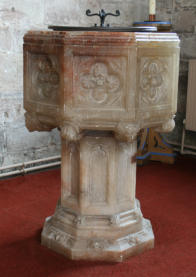
This later advertisement from 1884 shows that Henry Newton
had established his business in 1855 and the variety of products
produced.
It appears that by this date Henry had gained a wealth of
experience and knowledge or these minerals, their production
and use.
Click here for detailed product explanation
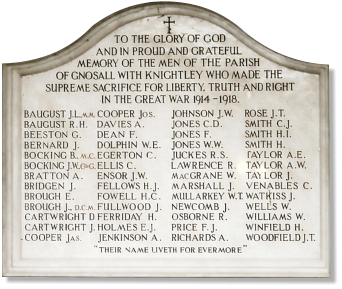
Henry died in 1902.
Cement manufacture had stopped by 1910 and the works was used by one of Henry’s sons, George Newton as a builders merchants.
This picture was taken from the canal towpath opposite the
Boat Inn and shows the Lime Kilns.
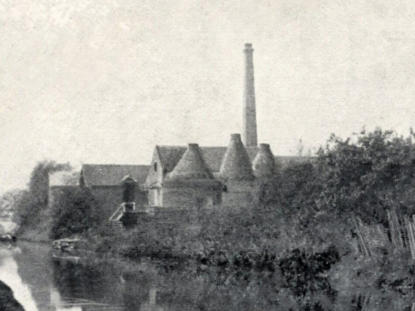
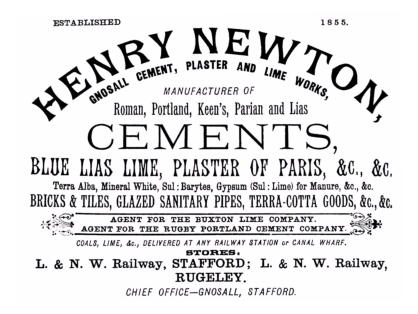
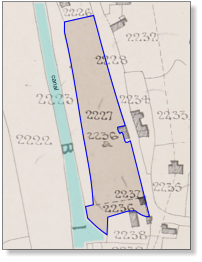
Despite the importance of the cement works, there is not much report of Henry senior taking part in village life, although he
attended a presentation at the Working Men’s Institute with other local dignitaries in 1879, and he (or his son) entered a
horse in the Stafford Agricultural Show in 1881, and an exhibit at Gnosall’s first Horticultural Show.
Henry ventured into property when he bought the old Toll Gate on Station Road from the “Stafford District Turnpike Roads”
trust for £110 - 10s in 1881 and sold it in 1889 to Mary Butler for £145. She later built “Oak Cottage” on the same site at the
junction with Wharf Road.
William Newton, Henry’s brother died in 1892 and Henry junior took over his uncle’s part of the J.C. Staton partnership and
moved to Stapenhill to run the cement business. Two of Henry senior’s daughters – Catherine Ann and Ann Staton – stayed
on in Gnosall for the rest of their lives, at White Rock on Mill Lane, and after a spell at Castle Church, Henry’s son George
moved back with his wife and daughters in the early 1900s following the death of his father, and lived next door to them.
It seems that Henry Newton’s other major impact on village life was to join with butcher William Gosnell in 1862 to set up a
Grand Rural Fete to rival the one established in 1860 by local farmers (including Thomas Belcher) and Gosnell. Also involved
in the breakaway Fete were surgeon George Baddeley and farmer James Belcher. It apparently did very well, but must have
caused bad feeling. As the rival fetes continued, the breakaway version concentrated more on horse racing; Gosnell and
Newton split the roles of clerk, judge and starter.
The Gnosall races were revived in 1889 with the Newton family taking an active part – Henry Newton junior was Starter and
his brother Frederick John was Clerk of the Course as well as entering his own horse ‘Wiseman’. An A. Newton and a J.
Newton were on the committee. There’s a transcription of a newspaper report of these races on the GHG site. Owing to the
soft ground, one of the older jockeys died. Click here to view details
Henry Newton was ill for the last part of his life, and attended by Dr. Steele. He died in December 1902 after a scalding
accident. Perhaps because he had been out of the public eye, his funeral was apparently not reported in the Staffordshire
papers, though the Wellington Journal reported that relatives and friends attended, and “many handsome wreaths were
sent”. He is buried with his wife and second son William in St Lawrence churchyard.
Henry’s daughters Catherine died 1929 and Ann in 1940. George continued to work as a cement and lime merchant, living
on Mill Lane with his two daughters. His funeral in 1945 was reported in the Staffordshire Advertiser.
George’s two daughters, Frances Kathleen and Phyllis, lived with their father and took part in village activities, notably in a
patriotic masque in 1911 to celebrate the coronation of George V and Queen Mary. The girls represented nations of the
British Empire.
Kathleen seems to have been the church organist and also played the piano at a concert to raise funds for the Memorial Hall
in 1921. In 1931 she married John Henry Findlay, son of the Gnosall police sergeant, apparently living at Mill Lane with her
father and sister. After her husband’s death in 1968, the sisters went on living together and are remembered locally. Phyllis
died in 1977 and Kathleen in 1980.
In their latter years, Mrs Findlay and Miss Newton were regular guests at the birthday teas of Mrs Frances Williams, a retired
farmer's wife who lived at Blythe House, along the Newport Road in Gnosall. Miss Newton had usually written the birthday
card and gift tag in her very distinctive, shaky style. The two ladies often delighted in talking about their most recent holiday.
One year, Miss Newton, who was slight in build and a little nervous in manner, told of how flattered she was that they had
been mistaken for mother and daughter, however, the larger, more confident Mrs Findlay was not so enthused at being
wrongly assumed to be her younger sibling's mother.
The Newton family and the community
This advertisement printed frequently in 1855 in a number of
local newspapers indicates a partnership between Newton and
Brett and at this time the business was in its infancy seemingly
trading as dealers.
In 1858 a newspaper article mentions “Henry Newton and
Charles Brett, Gnosall, fined one shilling and costs” for a
weights and measures infringement.
The name Charles Brett only appears once on the Gnosall
census records as an Innkeeper at the Lion Inn (Red Lion Inn)
in 1881.He died in April of the same year and is buried at Gnosall.
He was previously mentioned in a ‘Transfer of Licences’ notice in 1878 when he moved from The Fountain Inn to the Hornes
Inn. Click here for more information
In 1871 he is a lodger at Hixon and his occupation is “Plaster Manufacturer”. In earlier census records from 1861 and 1851
he is living with an aunt, Ann Newton at Chellaston and his occupation is “cordwainer” and “bootmaker”.
It is uncertain what his business relationship was with Henry Newton but appears to have been short lived.
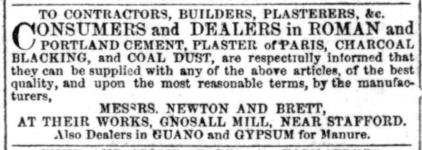

Acknowledgements:
Many thanks to Felicity Potter, Mike Barton, Valerie Gough and Malcolm Price for their valuable contributions.
Also to Miriam and Jeremy Manners for details from their family tree and J.C. Staton information
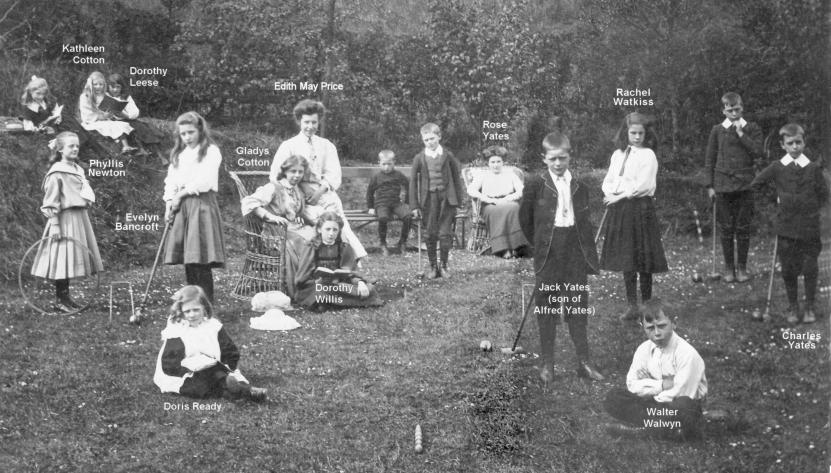
It also includes some cousins of Phyllis on the Wynne side namely :
•
Kathleen Cotton - daughter of John Cotton & Gwendoline Wynne
•
Gladys Cotton - daughter of John Cotton & Gwendoline Wynne
•
Edith May Price - daughter of Joshua Price & Kate Edith Wynne
(Kate Edith Wynne and Gwendoline Wynne were sisters of Agnes and Mary Wynne on the above family tree.)
This photograph was taken at the private school run by Rose Yates at ‘Sunnyside’ and shows Phyllis Newton -
daughter of George Newton and grand daughter of Henry & Mary Newton
.
Click above for home screen

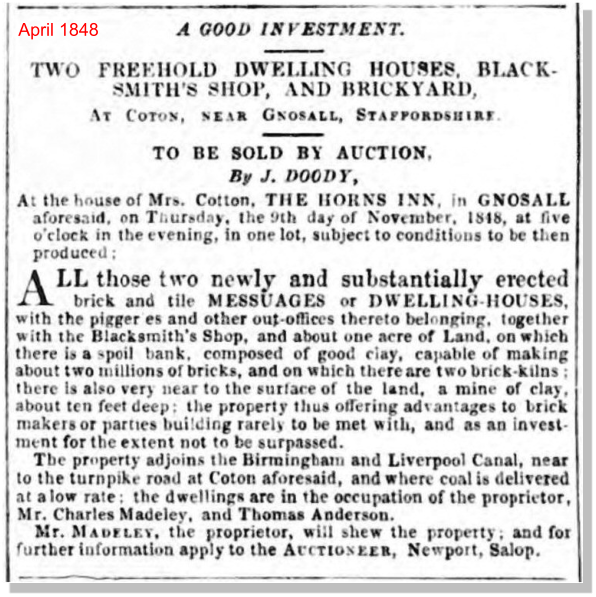
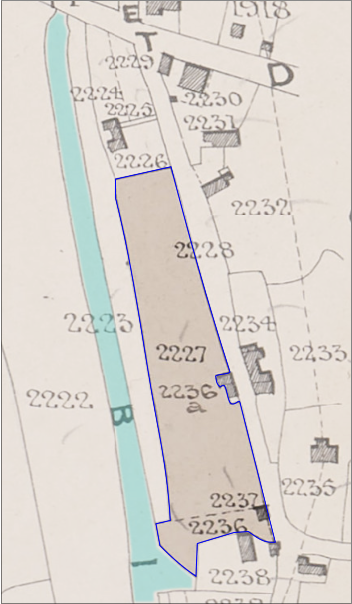

![The Races at Doley, 1889 GNOSALL THE RACES AT DOLEY For some time past efforts have been made to revive the old races, which were held in the Anchor field and which drew large numbers of people to the "city" by their means, thereby increasing the prospects of the various shopkeepers and business houses in the village. The enthusiasm of the villagers was great with respect to the old races and they were known to them as the "good old times," and wishes were expressed that they should be revived. Consequently, a meeting was held, and finally an energetic committee was formed, who succeeded in getting up a good programme, and an excellent list of officials and the race day has been looked forward to with much interest. The meeting was held on Monday last on Doley Common, and with the exception of the bad state of the course it may be said to have been a very successful meeting; but owing to the peaty nature of the soil the horses sank into it to a considerable distance, and in two or three cases were unable to get their feet out in time to keep their equilibrium, and consequently came to grief, throwing the rider over their heads. Had not this been the case the spectators would have seen some very good racing and better finishes than were under the circumstances witnessed. An instance of this would have been the case in the Consolation Race: for as soon as a start had been made, Gertrude got rid of her rider in the manner described above, while Eleanor Jane kept going. Gertrude was remounted and tried to pull up with her opponent, but could not get within 40 yards of her, although she was galloping better than Eleanor Jane at the finish, and no doubt would have made it a warm thing for her had not she fell. The Coley Stakes was the first on the programme, and although there were five entries, only two started. Mill Stream was made favourite, with 2 to 1 on; whilst 2 to 1 was freely taken against May Not. The pair were got away to a good start, and Mill Stream led until about a quarter of a mile from home, when May Not came up and won in a canter. All the entries started for the Newport Stakes, and Passing Shower was made favourite, evens at. The quartet were got off well, and a good race was expected, as they kept together well until about half the distance had been covered, when Eleanor Jane and Passing Shower came to grief; and the race was consequently left to Wiseman and Miller, with the latter leading. Wiseman came up about 50 yards from home and a good finish was expected, when a serious accident occurred. Owen, the jockey of Miller, who was near to the rope that enclosed the course, was doing all he could to win. Not far from the post, his horse swerved, when going at a tremendous pace, and the enclosure rope caught him just below the knees and took him clean off his legs, throwing his rider with great force on to the ground, and afterwards slipping on to his legs and the lower part of his body. Help was soon at hand, and he was taken into one of the tents in an unconscious state, in which he remained for some time. Dr. Morgan, of Gnosall, attended him, and did not hold very bright hopes of his recovery.[1] This unfortunate circumstance threw Passing Shower, who was re-mounted, a bad second, with Mr. F. J. Newton's Wiseman first. Miller's mishap would not have affected the position of Wiseman, as he was being held by his jockey, and would have won easily. The other races need no special comment. The following is the programme: [omitted.] The races which were under National Pony and Galloway Racing Rules may be termed a success and had the course been in better condition some good racing would have been witnessed, as some good horses were seen on the course. The arrangements shewed that the committee had taken the wants of the visitors into consideration, and gave general satisfaction. The meeting was held under the patronage of Sir T. F. Boughey, Bart., Sir Charles Nugent, Bart., Col. Masefield, R. H. Hargreaves, Esq., etc, STEWARDS: Mr. H. Harrison, Mr. W. H. Barton, Mr. A. Brown, Mr. T. Kirkland Rylands, Mr. G. Furber, Mr. A. Major. OFFICIALS: Starter, Mr. H. Newton, jun.; handicapper, Captain F. Herbert; judge and stakeholder, Mr. C. A. Ash; veterinary surgeon. Mr. W. Markham: clerk of scales, Mr. H. Fowell, Clerk of the course, Mr. Fred. J. Newton. COMMITTEE: Mr. W. Addison, Mr. S. Addison (both of Gnosall), Mr. W. S. Gilbert, Mr. J. Webb, Mr. Gardener, Mr. Dodd, Mr. A. Newton, Mr. H. M. Belcher, Mr. J. Newton, Mr. H. Powell, and Mr. D. Meadows. Mr. Shuker's band, Market Drayton, contributed some music during the afternoon and for dancing. Mr. Whittle, of Stafford, had the refreshment tents on the reserved portion of the ground, whilst Mr. Griffiths, the Anchor Inn Gnosall, had a tent on the Doley Common. Market Drayton Advertiser, 17-8-1889 [1] The jockey, an elderly [45] man named Charles Owen, was badly injured. He was afterwards removed to Stafford Infirmary, where he died next morning. Another accident occurred in the evening to two gentlemen returning to Eccleshall, their trap being overturned by the Anchor Inn, and one of the occupants very seriously hurt.Wellington Journal, 17-8-1889.](index_htm_files/21993.png)




















